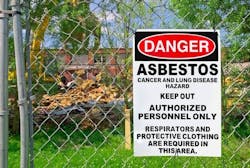As a manager or owner of your building, what keeps you up at night? An upcoming inspection? Maybe someone fell in the lobby and you’re worried about legal ramifications. Perhaps you’re in the middle of a remodel.
Whether it’s all of these or none, here’s a nightmare for you: a revival of soon-to-be EPA-approved materials containing asbestos.
It’s true. Even if you’re not mining the asbestos yourself or handling the construction materials containing it, it could be closer to you than you want it to be. It could cross over into interior design elements. It could be in the building items your upcoming remodel will use. If your building is older, it might still be in the pipe insulation in the basement.
Kadie Yale, former editor-in-chief of our sister publication interiors + sources, lays out the facts of the resurgence of this partially banned toxin that is back in the news. She also shares why you should be concerned about it.
Where is Asbestos Hiding in Interior Products?
Due to misunderstandings surrounding bans made on asbestos in the 1970s, it is generally thought that the crystalline material has faded out of use in recent decades.
Here’s more information from interiors+sources about where asbestos is hiding in products.
Asbestos are naturally occurring crystal fibrous materials that can resist fire, most chemical reactions and breakdowns, making them durable for a variety of uses, particularly in the building industry. (Pictured: asbestos chrysotile fibers that cause lung disease, COPD, lung cancer and mesothelioma. Photo: farbled)
Why are Asbestos Hazardous?
Research has shown that asbestos exposure is linked to high rates of:
- Mesothelioma — an aggressive form of cancer which occurs in the thin membrane (mesothelium) that protects vital organs in the chest and abdomen, including the lungs and heart. Mesothelioma can take 20-50 years to appear after exposure to asbestos and has a poor life expectancy, as there’s no current cure. In 2017, the Centers for Disease Control and Prevention reported 2,400-2,800 people were diagnosed in the United States each year; asbestos usage has decreased significantly since the 1970s.
- Lung cancer
- Asbestosis — a degenerative respiratory condition; a result from the formation of scar tissue on the surface of the lung linings (pleura). Although not deadly, asbestosis can be a precursor of mesothelioma
Isn’t Asbestos Banned in America?
No. While certain uses of asbestos were outlawed in the 1970s, including spray-on asbestos for insulation and/or fireproofing in buildings, many uses are still legal.
Under the Toxic Substances Control Act, asbestos manufacturing, importation, processing and distribution of asbestos-containing products is banned in the following categories:
- Corrugated paper
- Rollboard
- Commercial paper
- Specialty paper
- Flooring felt
Under the Clean Air Act, asbestos is banned for the following uses:
They are also banned in artificial fireplace embers and wall-patching compounds. For now.
Another health-concern: Is E-Waste Endangering Employees?
However, many uses for asbestos still haven’t been banned in the U.S. Unlike 60 countries where asbestos is banned, their use still occurs in the U.S. in many everyday items such as brake pads on vehicles.
Who Can Become Exposed?
The immediate group at risk of asbestos exposure are those who mine the material, are in the surrounding area of a mine and/or work with it, including those in construction.
People renovating buildings or in proximity to landfills which contain asbestos can be exposed to it, and there are reports of residents and structures in vicinity of an asbestos mine becoming covered in the toxin, as it can easily travel through air.
Why is Everyone Talking About it Now?
On July 31, 2018, Fast Company exposed the Environmental Protection Act’s notice released June 11, 2018, that proposed a significant new use rule (SNUR) for asbestos and asbestos-containing goods.
Now, the proposed SNUR would only relate to those in which asbestos aren’t currently being used, as identified by the EPA. That means those asbestos-containing goods that have been outlawed since the 1970s may now apply for approval by the EPA.
Approval will be granted on a case-by-case basis.
The following uses were identified in the EPA 40 CFR Part 721 rule:
- Adhesives
- Sealants
- Roof and non-roof coatings
- Arc chutes
- Beater-add gaskets
- Extruded sealant tape and other tape
- Filler for acetylene cylinders
- High-grade electrical paper
- Millboard
- Missile liner
- Pipeline wrap
- Reinforced plastics
- Roofing felt
- Separators in fuel cells and batteries
- Vinyl-asbestos floor tile
- And any other building materials besides concrete
Why Should We Be Worried?
This list opens the door to wide use of asbestos. While it isn’t clear what would make the EPA choose to allow or not allow the manufacturing, import and production of goods containing asbestos, President Donald Trump has made previous comments stating he doesn’t believe in the negative effects.
Because asbestos can become airborne, those who unknowingly use asbestos-containing goods or are exposed via proximity to a manufacturing plant or mine are in as much risk as those in the construction and design industries who come into contact with these goods on a regular basis.
Related: Fluorescent Lamp Disposal: Box and Store vs. Bulb CrushingCurrently there aren’t any asbestos mines in use in America, but this ruling by the EPA could allow for their reuse.
What Can We Do?
Those in the design and building industries can commit themselves to never using asbestos-latent products.
Katie Downing, digital content specialist at BUILDINGS, contributed to this article.
Two handpicked articles to read next:
About the Author

Kadie Yale
Former Architecture & Design Expert
Kadie Yale holds a BA in Industrial Design from San Francisco State University and MA in Decorative Art History and Theory from Parsons the New School.
